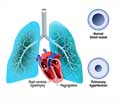A research team has identified an enzyme called PDE-9 as a 'multitasking offender' and a key instigator to heart failure.

Naturally found in the gut, kidneys and brain, PDE-9 is already a prime suspect in neurodegenerative conditions such as Alzheimer’s disease. Now, the new study shows the enzyme’s footprints are also present in heart cells and markedly elevated in patients with heart failure.
To understand the role of RDE-9 enzyme, the scientists exploited the knowledge that heart muscle health is safeguarded by two separate mechanisms, or signaling pathways. Activated by two different chemicals, nitric oxide and natriuretic peptide, each pathway produces cGMP, which in turn stimulates the heart muscle protector PKG. The researchers said that most cases of heart failure are fueled by breakdowns in both.
Researcher David Kass said, "The existence of two separate pathways with overlapping but distinct functions is nature’s insurance policy, a fail-safe redundancy to ensure that should one pathway falter, the other one can compensate and maintain heart muscle function."
Lead author Dong Lee added, "Like a play with multiple characters, heart muscle function is the result of a complex but perfectly synchronized interaction of several proteins, enzymes and hormones and the findings reveal that, like two subplots that converge in the end of the play, PDE-5 and PDE-9 are independent rogue operators, each leading to heart muscle damage but doing so through different means."
Researchers also note that heart failure treatments blocking the activity of PDE-9 may be just around the corner, with drugs that inhibit PDE-9 already being tested for use in people with Alzheimer’s disease. During the study, such PDE-9 blockers not only stopped heart muscle enlargement and scarring in mice with heart failure, but they nearly reversed the effects of the disease.
Advertisement
Source-Medindia















